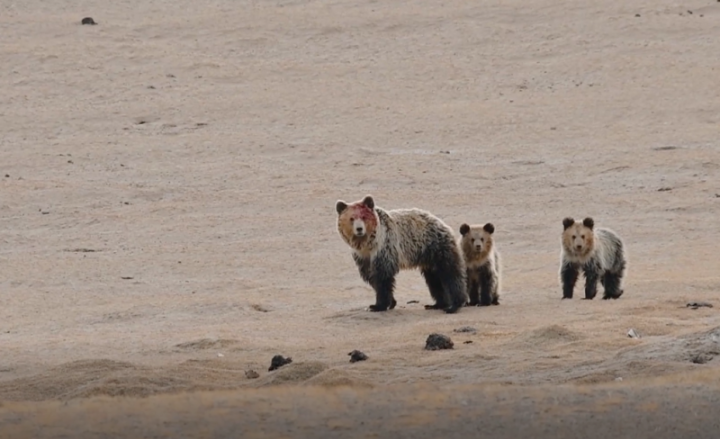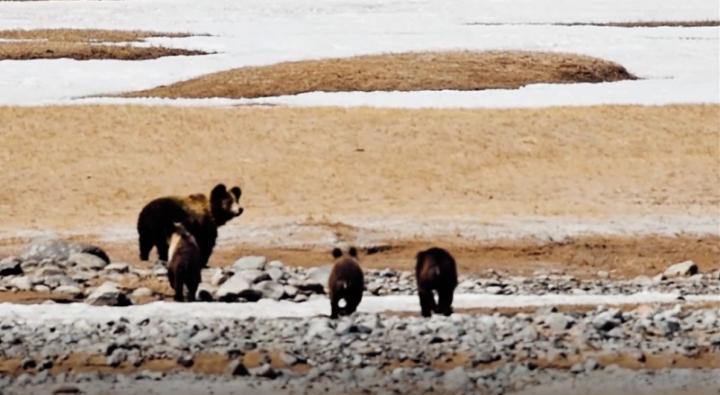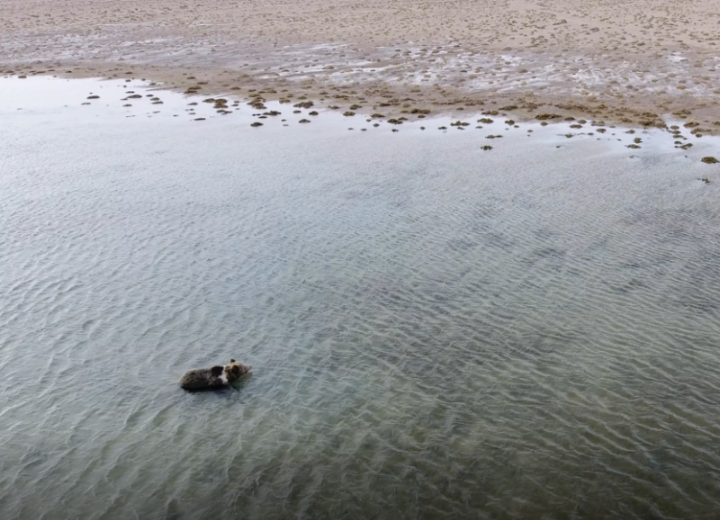In May, the season when horse bears awake from their winter slumber and start foraging, they are frequently seen in the Altun Mountain Nature Reserve, NW China’s Xinjiang.

Photo shows a horse bear photographed by staff during their patrol on May 10, 2022. (Photo by Li Huan)
“One week ago, we encountered horse bears twice when we were patrolling. Once it was two bears foraging around the Qiurkaka checkpoint, the other was a horse bear eating the body of a dead wild yak. I wanted to take more photos but the bear suddenly stood and roared when it noticed people approaching, and turned away after making sure there was no danger.” said Li Huan, the head of the Yixekpat management station, who just finished his patrol in the reserve on May 22, 2022. He also said that those horse bears that have awaken from their dormancy not only forage in pastures and wetlands, but also sneak into residential area of staff frequently.
“In early May, 2022, they went to the office of Qimtag Township government, opened the door of the dormitory, and looted all the instant noodles, mineral water and other edible food in the room. Fortunately, no one was in the office.” Tusun Sawutti, a patrolman at the station, said that a few days ago, he had preserved several sheep that were dead from cold in his fold and one of them was eaten by a horse bear.

Photo shows a horse bear family photographed by staff during their patrol in July, 2021, around the Qiurkaka checkpoint in the Altun Mountain National Nature Reserve, northwest China’s Xinjiang. (Photo by Xu Junquan)
Horse bear, also known as Tibetan brown bear, is one of the geographic sub-species of brown bear and is listed as a second-class protected animal in China. Horse bear is a little bit smaller than brown bear, and the hair is mainly brown and brown-black. Its neck fur is in white color and there is white stripe on the chest. Horse bear is omnivorous and it mainly hunts pikkas and marmots by digging burrows. It also eats dead animals, and sometimes eats birds and livestock, etc.. During dormancy, horse bear always looks for remote burrows to have habitat with irregular sleep and awakening time. In China, horse bears mainly live in Tibet and the Altun Mountains and Kunlun Mountains in Xinjiang.

Photo shows a horse bear family photographed by the staff during their patrol in July, 2021, in the Altun Mountain National Nature Reserve, northwest China’s Xinjiang. (Photo by Xu Junquan)
According to Zhao Xudong, director of publicity department of the Altun Mountain National Nature Reserve, a few years ago, only scientific researchers can occasionally see bears in the mountains, but in recent years, as the reserve keeps strengthening its ecological protection, the ecological environment has been improved gradually. All kinds of wildlife population have increased significantly, including horse bears. With the increasing population, horse bears' range of activity has greatly expanded, enabling them to be frequently seen in the reserve. “It reflects that the ecosystem of the reserve is intact and healthy, and the protection and management of the reserve has achieved initial results over the years.”

Photo shows a horse bear photographed by staff during their patrol in June, 2019. (Photo by Xu Junquan)
At present, in the Altun Mountain National Nature Reserve, the population of the three ungulate wild animals including Tibetan antelope, wild yak, Tibetan wild ass has exceeded 110,000, which is the highest in record. There are 338 species of wild animals, including snow leopard, black-necked crane, bearded vulture, Tibetan argali and horse bear, among which the number of the first-class protected animal in China that have inhabited here has increased to 17 kinds and the second-class to 31.









